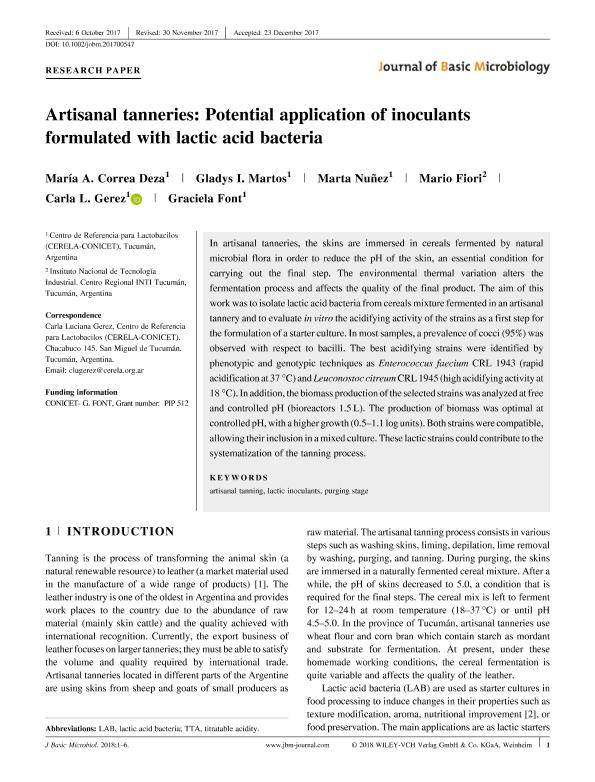Artículo
Artisanal tanneries: potential application of inoculants formulated with lactic acid bacteria
Correa Deza, Maria Alejandra ; Martos, Gladys Irma
; Martos, Gladys Irma ; Nuñez, Martha Susana
; Nuñez, Martha Susana ; Fiori, Mario; Gerez, Carla Luciana
; Fiori, Mario; Gerez, Carla Luciana ; Font, Graciela Maria
; Font, Graciela Maria
 ; Martos, Gladys Irma
; Martos, Gladys Irma ; Nuñez, Martha Susana
; Nuñez, Martha Susana ; Fiori, Mario; Gerez, Carla Luciana
; Fiori, Mario; Gerez, Carla Luciana ; Font, Graciela Maria
; Font, Graciela Maria
Fecha de publicación:
04/2018
Editorial:
Wiley VCH Verlag
Revista:
Journal of Basic Microbiology
ISSN:
0233-111X
e-ISSN:
1521-4028
Idioma:
Inglés
Tipo de recurso:
Artículo publicado
Clasificación temática:
Resumen
In artisanal tanneries, the skins are immersed in cereals fermented by naturalmicrobial flora in order to reduce the pH of the skin, an essential condition for carrying out the final step. The environmental thermal variation alters thefermentation process and affects the quality of the final product. The aim of this work was to isolate lactic acid bacteria from cereals mixture fermented in an artisanal tannery and to evaluate in vitro the acidifying activity of the strains as a first step for the formulation of a starter culture. In most samples, a prevalence of cocci (95%) was observed with respect to bacilli. The best acidifying strains were identified by phenotypic and genotypic techniques as Enterococcus faecium CRL 1943 (rapid acidification at 37 °C) and Leuconostoc citreumCRL1945 (high acidifying activity at 18 °C). In addition, the biomass production of the selected strains was analyzed at free and controlled pH (bioreactors 1.5 L). The production of biomass was optimal at controlled pH, with a higher growth (0.5?1.1 log units). Both strains were compatible,allowing their inclusion in a mixed culture. These lactic strains could contribute to the systematization of the tanning process.
Palabras clave:
Artisanal Tanning
,
Lactic Inoculant
,
Purging Stage
Archivos asociados
Licencia
Identificadores
Colecciones
Articulos(CERELA)
Articulos de CENTRO DE REFERENCIA PARA LACTOBACILOS (I)
Articulos de CENTRO DE REFERENCIA PARA LACTOBACILOS (I)
Citación
Correa Deza, Maria Alejandra; Martos, Gladys Irma; Nuñez, Martha Susana; Fiori, Mario; Gerez, Carla Luciana; et al.; Artisanal tanneries: potential application of inoculants formulated with lactic acid bacteria; Wiley VCH Verlag; Journal of Basic Microbiology; 58; 4; 4-2018; 296-301
Compartir
Altmétricas



